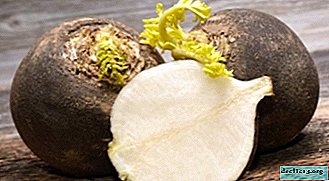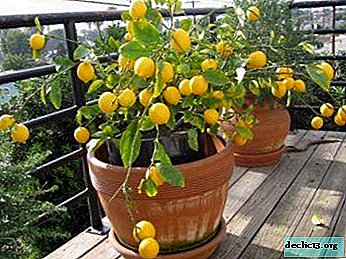Multifloral beauties - polyanthus roses. Photos, instructions for growing from seeds, care tips

The variety of classes and varieties of roses is fascinating and impressive. Weaving, miniature, hybrid tea, floribunda ...
Tens, hundreds of great varieties and varieties! There is a place for beauty lover of this stunning flower. Polyanthus roses look bright and dignified among this luxurious abundance. Unpretentious and very beautiful, these magnificent plants will decorate any flower garden or garden.
What it is?
Polyanthus roses - which means "multi-flowered" - are plants with lush inflorescences of dozens of flowers.Flowers are small in diameter (about 4-6 cm, some varieties are large-flowered, up to 10 cm). The inflorescences are generously strewn with bushes, and it looks truly bewitching. The plant itself is a shrub, the height of which depends on the variety. There are compact options literally 30 cm high, there are large ones - they reach a meter and even a meter and a half in height. Glossy, most often dark green leaves cover stems in abundance.
History of occurrence
 Polyanthus roses were brought out at the end of the century before last by flower grower-breeder from France Jean-Baptiste Guillot.
Polyanthus roses were brought out at the end of the century before last by flower grower-breeder from France Jean-Baptiste Guillot.
Crosses were Chinese tea roses and miniature multi-flowering varieties from Japan. Thanks to this hybridization, very interesting plants were obtained.
Roses from China gave hybrids bright beautiful flowers. From Japanese roses, hybrids took abundant bright foliage and large inflorescences of dozens of flowers.
Distinctive features of this species
Interestingly, polyanthus varieties of roses have almost no thorns. The color scheme is red, pink, orange, and white. Sometimes there are varieties with flowers, painted immediately in two shades. Unlike many other capricious types of roses, polyanthus are unpretentious, winter well even in the harsh conditions of the Urals and Siberia, and easily reproduce, transmitting varietal characters. The flowers of polyanthus roses (almost all varieties) have no aroma.
Description of varieties
Varieties of polyanthus roses are usually divided into subgroups: undersized and coarse.
The first - bushes up to 60 cm tall. Examples of varieties:
- Border King (flowers with a white middle and red border).
- The Fairy (pink flowers).
- Snow Ballet (white flowers with aroma).
The second - plants up to 150 cm tall, large-flowered. Examples of varieties:
- Iceberg - white flowers.
- Holstein - ruby petals.
- Kate Bayer - combines shades of orange and coral.
Photo
In the photo below you can see how polyanthus roses look.
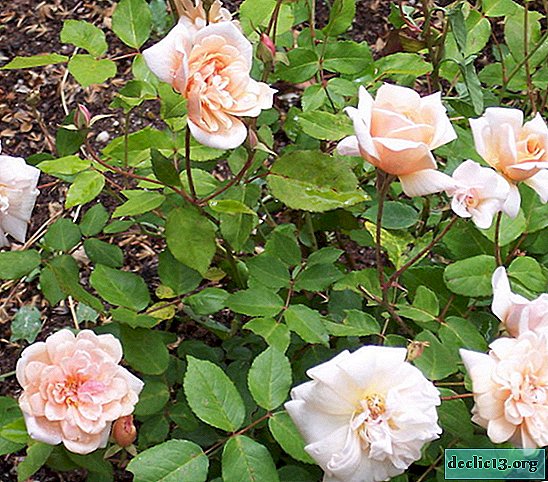
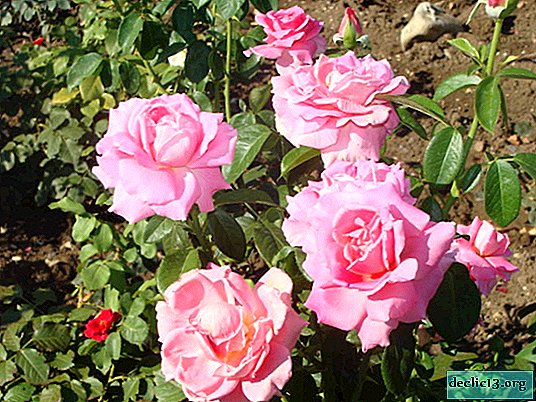


Bloom
Polyanthus roses bloom very willingly and abundantly. Flowering lasts continuously throughout the summer and almost until the end of autumn. Lush inflorescences succeed each other for many months.
Another difference of polyanthus roses from other groups is that wilted flowers do not fall by themselves. To preserve the decorative, neat appearance of the bush, it is necessary to periodically remove faded inflorescences.Care before and after flowering
In order to prepare roses for good flowering, it is necessary to start top dressing in the spring. Pruning of shoots after the appearance of leaves in spring is also recommended: it has a good effect on future flowering. Specific care after flowering is to remove wilted flowers.
What to do if it does not give buds?
One of the possible reasons why the rose does not bloom: too high concentration of fertilizers during feeding. Do not forget to plant fertilizers abundantly with waterotherwise the root system may be affected.
If the soil is too overloaded with nitrogen fertilizers, then the rose may lush green, but not bloom at the same time. And vice versa: when the soil is poor in nutrients, the plant is weakened, grows poorly, it has no forces for flowering. You can add superphosphate: it contains phosphorus, which has a good effect on the flowering of roses.
Perhaps the rose was originally planted incorrectly. She lacks light or does not fit the ground. In this case, the plant, of course, will stretch, get sick, feel not in the best way. You can try to transplant the shrub to a place more suitable for the rose.
After flowering, we do not prune: the plant can hardly tolerate such an intervention, and may not produce flowers for the next year.
Use in landscape design
Bushes of polyanthus roses fit perfectly into the atmosphere of a private garden, and in the composition near the city buildings. Hedges are planted from them along paths, roads, sidewalks. They look great in rabatki (long flower beds), rockeries, on lawns. They are good both on their own and in combination with other colors. In the landscape gardening art they have long occupied a worthy place!
Landing and Care Guide
 Choosing a landing place. Choose a well-lit area for planting these roses: they love light and only in good light will show all their beauty. Please note: they need to be placed where there are no strong through winds. Areas with too wet soil, water stagnation for polyanthus roses will not work.
Choosing a landing place. Choose a well-lit area for planting these roses: they love light and only in good light will show all their beauty. Please note: they need to be placed where there are no strong through winds. Areas with too wet soil, water stagnation for polyanthus roses will not work.- What should be the soil? Polyanthus rose loves light loamy soil with an abundance of humus: loose, well-permeable to air and moisture. Cretaceous or sandy soils for roses will not work. They freeze too quickly in winter, in summer - they warm up to high temperatures. The nutrients in them do not persist for long.
- Seed planting. Like other roses, this group can be successfully propagated by cuttings. However, it is polyanthus roses that propagate perfectly by seeds, while maintaining varietal characteristics. Growing beautiful flowers from seeds is not a quick, but not the most difficult process, the main thing here is proper care.
- Temperature. Polyanthus roses are frost-resistant plants. They can be grown even where ordinary roses with low temperatures can not cope. These plants winter well under shelter, even in Siberian frosts down to -30C. In summer, roses can withstand high temperatures (30C and higher). Petals can fade slightly in the sun, however, some varieties are resistant to such fading.
- Watering. Polyanthus roses are watered once a week. Take care not to water the soil. If the weather is damp and the ground has not dried out, wait a bit with watering.
- Top dressing. We fertilize roses for the first time in May. For polyanthus roses, it is good to use chicken droppings or mineral fertilizers.
- It is necessary to dilute the fertilizer with water at the rate of 1 part of fertilizer in 20 parts of water.
- Leave the solution for a week, then dilute with water three more times.
- Then water the rose bushes.
- The next time the plants are fertilized when the buds begin to form (the first and second flowering waves).
For roses, fertilizing with phosphates and potash fertilizers is also good.
- Pruning.
- The rose is carefully trimmed in the spring, before flowering.
- Sick, old, dead shoots are removed.
- Healthy shoots prune about a third. A little pruning should be done during the summer.
We also remove the shoots growing inside the bush (to avoid infection of the rose with diseases and parasites).
 Transfer. If for one reason or another it is required to transplant a bush, then this is not a problem: polyanthus roses normally tolerate a transplant. It is only important not to damage the root system of the plant (try to dig out with a sufficient lump of earth on the roots). If something went wrong and the roots were still damaged, then the shoots of the bush should be cut short.
Transfer. If for one reason or another it is required to transplant a bush, then this is not a problem: polyanthus roses normally tolerate a transplant. It is only important not to damage the root system of the plant (try to dig out with a sufficient lump of earth on the roots). If something went wrong and the roots were still damaged, then the shoots of the bush should be cut short.- Preparation for winter. Despite its frost resistance and undemanding nature, a polyanthus rose cannot winter without shelter. Of course, if you are in the Crimea or the Krasnodar Territory, where mild winters, then you can do without it. However, in other regions of the country you need to take care of your favorite plants in advance. The algorithm is as follows:
- We exclude nitrogen fertilizers from the second half of summer.
- We bring in phosphorus-potassium fertilizers (they will help the plant prepare for winter).
- We make sure that the plant is not affected by parasites and diseases.
- In areas with mild winters, you can make a light shelter by pouring about 30-40 cm in height into the center of the bush.
- If we are talking about areas with harsh winters, then the bushes need to be covered with spruce branches, peat, dry foliage, sand. You can fix large sheets of roofing material on top of the spruce branches and on top a layer of polyethylene.
Shelter is made only when the temperature drops to -5-7C. Before this, the plant "hardens" in the cold. We cover the plants only after the leaves have completely fallen. Before this, an antifungal treatment can be carried out. For shelter, you should choose a day with dry and frosty weather. You can not cover plants with hay, straw, moss and any other materials that absorb water. Roses under such material will damp and rot.
How to grow from seeds at home - step by step instructions
Polyanthus roses can be propagated by conventional cuttings and grafting on rose hips (just the polyanthus group does not lose its qualities with such an inoculation). However, seed propagation is very popular. How it's done?
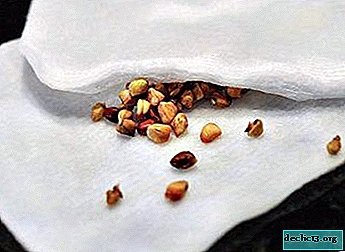 Soak the seeds for two weeks, and plant them in December at home in moist, loose soil. Make a thin layer of perlite mulch on top. We cover the container with a glass or polyethylene.
Soak the seeds for two weeks, and plant them in December at home in moist, loose soil. Make a thin layer of perlite mulch on top. We cover the container with a glass or polyethylene.- The next step is to place the container with seeds in the cold (it is possible in an ordinary refrigerator, in a cellar or cellar). We periodically water a little so that the soil remains moist (do not "overfill"!). In such conditions, leave the seeds for a month (we temper them in this way). In a month, shoots will appear. We place the capacity where it is fresh (15-18 degrees) and light (but without direct sunlight).
- By spring, the plant will grow and get stronger. When the warm days come (late April - early May), plant bushes in pits with coarse sand poured as drainage, as well as with compost and ash. The depth of the pits is up to ten centimeters. If you plan to plant bushes in one line, then a distance of 30-40 cm should remain between them.
Diseases and Pests
Polyanthus roses are resistant not only to weather conditions, but also to pest damage. Of course, it is worth processing roses in the winter from a fungus (and, if necessary, in the warm season). However, parasitic insects are not often interested in these roses. The most specific pest is aphids. If you noticed that aphid colonies appeared on roses, get a drug against this parasite and treat it two to three times a season on a dry and windless day.
Polyanthus roses - a real gift for the gardener. They are not capricious, do not ask for intricate care, are content with little. They are ready to please their master with flowering for many months, subject to the minimum growing conditions. Polyanthus roses perfectly withstand competition with a more modern group of varieties - floribunda, without losing ground and decorating the world with its abundant flowering.

 Choosing a landing place. Choose a well-lit area for planting these roses: they love light and only in good light will show all their beauty. Please note: they need to be placed where there are no strong through winds. Areas with too wet soil, water stagnation for polyanthus roses will not work.
Choosing a landing place. Choose a well-lit area for planting these roses: they love light and only in good light will show all their beauty. Please note: they need to be placed where there are no strong through winds. Areas with too wet soil, water stagnation for polyanthus roses will not work. Transfer. If for one reason or another it is required to transplant a bush, then this is not a problem: polyanthus roses normally tolerate a transplant. It is only important not to damage the root system of the plant (try to dig out with a sufficient lump of earth on the roots). If something went wrong and the roots were still damaged, then the shoots of the bush should be cut short.
Transfer. If for one reason or another it is required to transplant a bush, then this is not a problem: polyanthus roses normally tolerate a transplant. It is only important not to damage the root system of the plant (try to dig out with a sufficient lump of earth on the roots). If something went wrong and the roots were still damaged, then the shoots of the bush should be cut short. Soak the seeds for two weeks, and plant them in December at home in moist, loose soil. Make a thin layer of perlite mulch on top. We cover the container with a glass or polyethylene.
Soak the seeds for two weeks, and plant them in December at home in moist, loose soil. Make a thin layer of perlite mulch on top. We cover the container with a glass or polyethylene.





